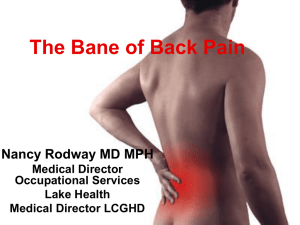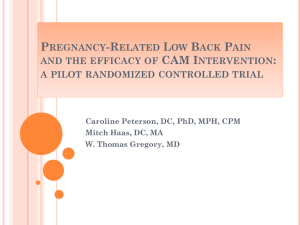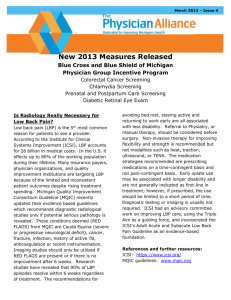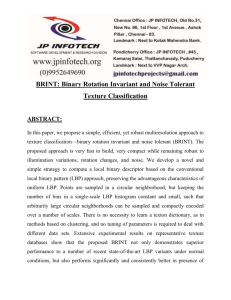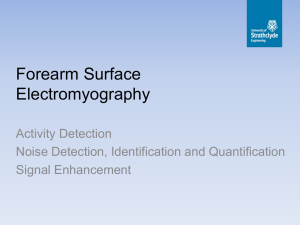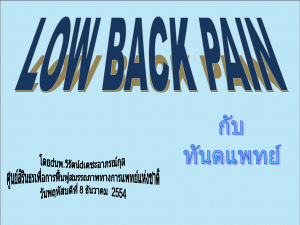Hard Copy
advertisement
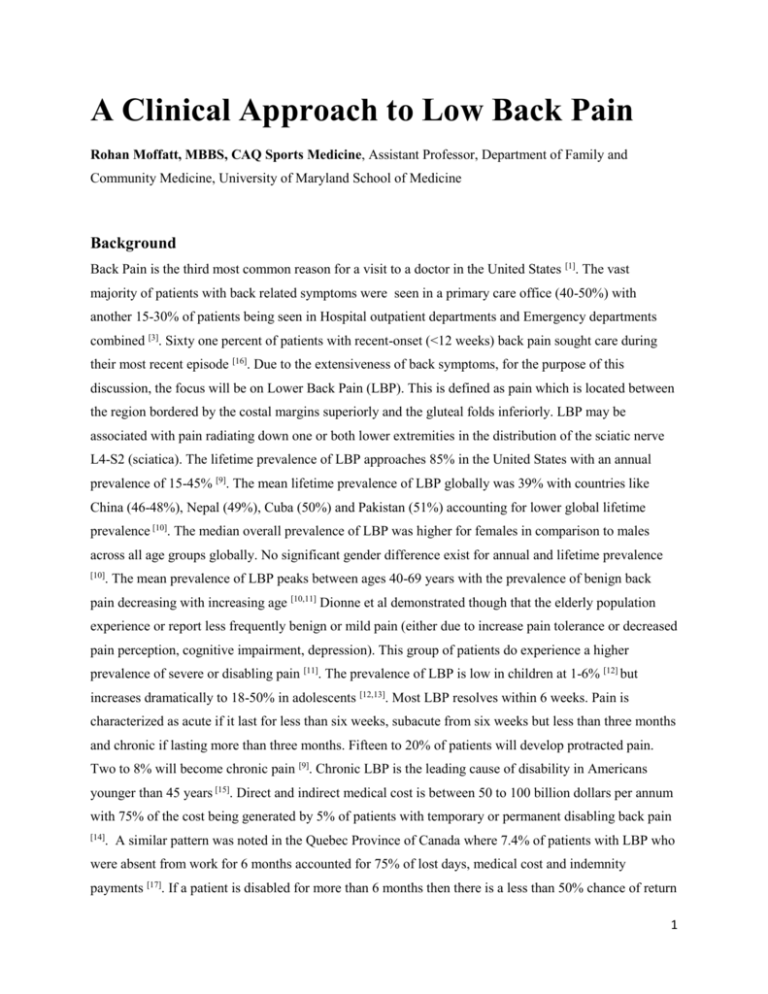
A Clinical Approach to Low Back Pain Rohan Moffatt, MBBS, CAQ Sports Medicine, Assistant Professor, Department of Family and Community Medicine, University of Maryland School of Medicine Background Back Pain is the third most common reason for a visit to a doctor in the United States [1]. The vast majority of patients with back related symptoms were seen in a primary care office (40-50%) with another 15-30% of patients being seen in Hospital outpatient departments and Emergency departments combined [3]. Sixty one percent of patients with recent-onset (<12 weeks) back pain sought care during their most recent episode [16]. Due to the extensiveness of back symptoms, for the purpose of this discussion, the focus will be on Lower Back Pain (LBP). This is defined as pain which is located between the region bordered by the costal margins superiorly and the gluteal folds inferiorly. LBP may be associated with pain radiating down one or both lower extremities in the distribution of the sciatic nerve L4-S2 (sciatica). The lifetime prevalence of LBP approaches 85% in the United States with an annual prevalence of 15-45% [9]. The mean lifetime prevalence of LBP globally was 39% with countries like China (46-48%), Nepal (49%), Cuba (50%) and Pakistan (51%) accounting for lower global lifetime prevalence [10]. The median overall prevalence of LBP was higher for females in comparison to males across all age groups globally. No significant gender difference exist for annual and lifetime prevalence [10] . The mean prevalence of LBP peaks between ages 40-69 years with the prevalence of benign back pain decreasing with increasing age [10,11] Dionne et al demonstrated though that the elderly population experience or report less frequently benign or mild pain (either due to increase pain tolerance or decreased pain perception, cognitive impairment, depression). This group of patients do experience a higher prevalence of severe or disabling pain [11]. The prevalence of LBP is low in children at 1-6% [12] but increases dramatically to 18-50% in adolescents [12,13]. Most LBP resolves within 6 weeks. Pain is characterized as acute if it last for less than six weeks, subacute from six weeks but less than three months and chronic if lasting more than three months. Fifteen to 20% of patients will develop protracted pain. Two to 8% will become chronic pain [9]. Chronic LBP is the leading cause of disability in Americans younger than 45 years [15]. Direct and indirect medical cost is between 50 to 100 billion dollars per annum with 75% of the cost being generated by 5% of patients with temporary or permanent disabling back pain [14] . A similar pattern was noted in the Quebec Province of Canada where 7.4% of patients with LBP who were absent from work for 6 months accounted for 75% of lost days, medical cost and indemnity payments [17]. If a patient is disabled for more than 6 months then there is a less than 50% chance of return 1 to work. If LBP is disabling for 2 years then return to work is almost unlikely [9]. The economic burden and prevalence makes LBP a condition of importance for which significant implications for care are derived. Risk factors Numerous risk factors have been identified for which an increased likelihood exist for the development of LBP. These include age with a peak occurring in the middle age group range [10,11]. Studies have revealed that genetic factors play a role in the heritability of LBP in monozygotic twins [18,19]. Other risk factors include obesity [19], tobacco smoking, poor posture (due to weakness of trunk extensors in comparison to flexors), occupation (manual labor, vibration exposure, prolonged standing or sitting[20] and job dissatisfaction) and lower educational level [4]. Diagnosis History This should be focused on identifying risk factors for LBP and red flags for more serious causes of pain. It is appropriate to note the age of patient, characterise the nature of pain by location, onset, duration, radiation, nocturnal occurrence, severity and modifying factors. The examiner will want to determine if current or past history of trauma might be related to LBP. Positive tobacco use in social history as well the current use of oral corticosteroids both have implications for osteoporosis. Enquire about previous surgical procedures on the lower back, past medical history of cancer as well as screen for depression and anxiety which both may impact recovery. Red flags that warrant urgent attention include LBP in an immunocompromised patient, presence of fever, unexplained weight loss, intravenous drug abuse, saddle anesthesia, bowel/bladder dysfunction, unexplained weakness, paresthesia and colicky pain [24]. The examiner can also probe for barriers to recovery from LBP, sometimes referred to as “yellow flags”. These include fear and avoidance beliefs [5], heightened emotional activity, depression, dysthymia, anxiety disorders [6], personality disorders, predisposition to somatoform pain disorder and childhood sexual abuse. Physical examination First observe the patient’s gait and ability to independently maneuver their surroundings during interview. This might provide some objective insight into the the patient’s functional status. Make note of the patient’s attire, posture and overall demeanor. Observe for signs of nutritional inadequacies as well as 2 checking the body mass index. Check the patient’s temperature, blood pressure and peripheral pulses for any significant radio-femoral delays. The patient’s ability to walk on tip-toes or on heels provides gross assessment of S1-2 and L4-5 nerve roots respectively. Systematic evaluation of the cardiovascular, gastrointestinal (inclusive of a rectal exam for sphincter tone, saddle anesthesia) and lymphatics should ensue. With the patient standing, evaluate the back for signs of asymmetry, scoliosis, increased lordosis or surgical scars. Palpate the back for any bony tenderness or muscle spasms. The examiner should include palpation of the sacroiliac joints as part of the evaluation of LBP. While standing with both feet together, observe for range of motions deficits elicited from active forward flexion at the waist (Schober test), passive rotation of the shoulders and pelvis in the same plane in either directions. Axial loading of the spine by direct pressure on the head should be performed while standing. Facet joint related pain is aggravated with hyperextension of spine and relieved with flexion which is opposite to discogenic related pain. In the supine position, check for limb length discrepancy and range of motion of the hips. A straight leg raise (SLR) test should be performed by passively flexing the hip while maintaining extension of the knee. The accuracy of the SLR test is inconsistent and false positives may inflate the sensitivity of the test[21]. The SLR test can also be performed with the patient sitting by extending the knee joint. The bowstring test is a modification of the SLR test. Once a level of discomfort is achieved with the supine SLR test, the knee is flexed enough just to relieve the pain. At that point, pressure is applied to the popliteal fossa which may cause a recurrence of symptoms (a positive test result). Perform the FABER test which involves Flexion, ABduction & External Rotation of the hip to identify pain originating from the sacroiliac joints. A neurological examination should conclude the physical examination with special attention placed on strength evaluation, deep tendon reflexes and sensory deficits Table 1. Waddell et al described five categories upon which back pain with psychological component can be identified. Some of the individual components that form the basis of his criteria were described earlier. These include TENDERNESS from light palpation or in a non-anatomic distribution, SIMULATION of movements such as axial loading/passive rotation of torso while standing causing pain, DISTRACTION of the patient while rechecking SLR, REGIONAL DISTURBANCES marked by sensory loss or weakness in a non neurological or anatomical pattern and OVERREACTION characterized by disproportionate pain response, dramatic grimacing, bracing and clutching painful area for more than 3 seconds. It is still possible for the patient to have an organic cause of pain with positive Waddell criteria. Table 1. Dermatomal sensory, reflex and functional muscle test Root Muscle Action Sensory Loss L2 Hip flexion Mid-anterior thigh Reflex 3 L3 Knee extension Lateral thigh to medial femoral condyle Patellar L4 Ankle dorsiflexion Medial malleolus Patellar L5 Great toe extension Lateral leg and dorsum of foot Medial hamstring S1 Ankle plantarflexion Lateral aspect of calcaneus Achilles Differential Diagnosis These can be classified into mechanical, systemic and referred pain. Mechanical conditions are responsible for 98% of the causes of LBP[22] Mechanical Degenerative disc disease (with or without radiculopathy), lumbar stenosis, cauda equina syndrome, myofascial (sprains or strains), facet joint arthropathy, vertebral fractures, spondylosis, spondylolysis and spondylolisthesis (pars interarticularis defects), hip joint pain, sacroiliac joint pain (sacroiliitis) Systemic Myelopathy, myositis, spinal segmental & lumbopelvic dystonia, lumbosacral plexopathy (diabetes, vasculitis, malignancy), mononeuropathy, primary or metastatic neoplasms, seronegative spondyloarthropathy (Reiter's syndrome, Ankylosing spondylitis), Metabolic bone disease (paget's disease, osteoporosis) Referred Gastrointestinal (pancreatitis, pancreatic cancer, cholecystitis, intestinal obstruction, peptic ulcer disease), genitourinary (nephrolithiasis, pyelonephritis, prostatitis), Cardiovascular (thoracic or abdominal aortic aneurysm), Hip joint disorders (osteoarthritis, avascular necrosis). Other less understood but well documented pain syndromes responsible for LBP include Failed Back Surgery Syndrome (FBSS) and Complex Regional Pain Syndrome (CRPS) Investigations Hematological studies where indicated by history and examination include CBC, ESR, CRP, Alkaline phosphatase, serum calcium and parathyroid hormone. SPEP and UPEP should be ordered if multiple myeloma is being entertained. A urinalysis with microscopy may assist with ruling out conditions related to the urinary tract. Imaging studies are usually not required initially for the evaluation of non specific LBP[23]. These are usually reserved for pain which do not respond to the usual mode of treatment, persisting for over six weeks. There are certain instances however when imaging studies should be ordered at initial evaluation 4 of the patient with LBP. These include the presence of red flags as described earlier, a history of acute trauma and a past medical history of cancer. Initial testing should include plain radiographs of the Lumbosacral spine (AP, lateral and oblique), pelvic x-ray if indicated by history or examination. If these initial test prove non-diagnostic or in the presence of neurological findings then a MRI scan is warranted. Patients with previous Lumbar spine surgeries might benefit more from a CT myelogram to avoid distorted MRI images caused from hardware in-situ. Other diagnostic test which may be indicated based on history and examination include Electromyogram (EMG), Somatosensory evoked potential testing (SSEP), Nerve conduction study (NCS) and a bone scan. Treatment All patients should be provided with evidenced based information on LBP with regards to expected course, advise on remaining physically active and self care options [23]. It has been demonstrated that controlled exercises helps to restore function, reduce pain, distress and illness related behavior thus promoting a return to work [27]. Non pharmacological therapies with good evidence of moderate efficacy for chronic or subacute low back pain are cognitive-behavioral therapy, exercise, spinal manipulation and interdisciplinary rehabilitation. Superficial heat was the only therapy with good evidence of efficacy for the treatment acute low back pain [25]. Pharmacological options available for the treatment of LBP include acetaminophen, Nonsteroidal antiinflammatory drugs (NSAIDs), Cyclooxygenase 2 (COX 2) inhibitors, oral corticosteroids, Opioids, muscle relaxants (benzodiazepines and non-benzodiazepines), antiepileptic drugs (AED), antidepressants and topical (lidocaine, diclofenac). NSAIDs, COX2 inhibitors and oral corticosteroids are anti-inflammatory and inhibit the production of cytokines that are responsible for pain generation and tissue edema. Opioid analgesia act by inhibiting the ascending pain pathways at the level of the spinal cord thus producing analgesic effect. When considering the level and duration of opiod analgesia to prescribe, the physician should rely on the patient’s achievement of vocational, recreational and social goals as better measures of medication efficacy than the subjective report of pain relief. All patients being considered for opioid therapy should have screening assessment performed to identify risk factors for adverse outcome, developing abuse or addiction. Currently available screening tools include National Institute of Drug Abuse (NIDA) quick screen, The Opioid Risk Tool (ORT), The Diagnosis, Intractability, Risk, Efficacy (DIRE) tool and The Screener and Opioid Assessment for Patients with Pain-Revised (SOAPP-R). Skeletal muscle relaxants and antispasmodics are centrally acting medications which promote generalized muscle relaxation and sleep. Short term use is recommended due to the increased potential for dependence and side effects. 5 AEDs and antidepressants are neuromodulators which act centrally to alter the interpretation of pain. Gabapentin is the most popular of the AEDs however dose will have to be titrated to effect. The antidepressants commonly used for LBP include Tricyclic Antidepressants (TCA), Selective Serotonin Reuptake Inhibitors (SSRI) and Serotonin-Norepinephrine Reuptake Inhibitors (SNRI). There is good evidence in support of acetaminophen, NSAIDs, Skeletal Muscle relaxants for acute LBP and TCA for chronic LBP. However the evidence is fair in support of opioids, tramadol, Benzodiazepine and gabapentin being effective for pain relief. No evidence has been found in support of systemic corticosteroid use in the treatment of LBP [26]. Acupuncture therapy provides a viable alternative to oral options for the management of LBP. Interventional therapy are reserved for LBP with a specific cause. Intra-articular facet joint block and radiofrequency medial branch neurotomy are used to treat facet joint arthropathy related pain. Epidural corticosteroid injections are used for treatment of spinal stenosis. Vertebral body fracture can be treated with vertebroplasty. Spinal cord stimulators have been shown to be effective for FBSS and CRPS. Surgery is recommended for the treatment of LBP secondary to significant intervertebral disc herniation resulting in compression of neural tissues. Prevention The following recommendations on preventing LBP are evidenced based and were obtained from systematic searches of scientific literature. Strong scientific evidence exist in support of the following recommendations: Physical exercise helps to reduce the occurrence, duration of LBP and limit work absence [8,28]. Back schools which teach lifting techniques, offer advice on biomechanics and optimal postures are not recommended. Lumbar supports and back belts are no more helpful than no intervention and hence not recommended for use in the prevention of back pain. The use of shoe orthoses is not recommended for the prevention of LBP [28]. Low scientific evidence exist in support of pain reduction with change from a firm to a medium-firm mattress [28]. Referrals Patients with cauda equina syndrome, acute vertebral fractures, cord compression, progressive neurological deficits and the suspicion for infection will require urgent referral for treatment. 6 References 1. Why patients visit their doctors: Assessing the most prevalent conditions in a defined American population, Mayo Clinic Proceedings, Jan 2013, vol 88, Issue 1, pg 56-67. Jennifer L. St. Sauver, PhD, MPH; David O. Warner, MD; Barbara P. Yawn, MD, MSc 2. The prevalence and management of low back pain across adulthood: Results from a population-based cross sectional study (the MUSICIAN study) Pain: Jan 2012, vol 153, issue 1, p27-32 Mcfarlane, Gary; Beasley, Marcus; Jones, Elizabeth; Docking, Rachael; Keely, Phillip; McBeth,John; Jones, Gareth. 3. Vital and Health Statistics, series 13, number 159, Feb 2006 Ambulatory Care visits to physician offices, hospital outpatient departments and emergency departments: United States, 2001-02 4. Updated epidemiological estimates of subacute and chronic low back pain in United States adults. American Journal of Physical Medicine and Rehabilitation. Mar2014. Siddiqui, Imran; Gerrard, Paul 5. Predictors of short term work related disability among active duty US Navy personnel: a cohort study in patients with acute and subacute low back pain. Spine, Sep2012, Vol 12 Issue_9, p806-816. Hiebert, Rudi; Campello, Marco; Weiser, Sherri; Ziemke, Gregg; Fox, Bryan; Nordin, Margareta 6. The association between chronic back pain and psychiatric disorders; results from a longitudinal population based study. European psychiatry. Jan 2012 Supplement, vol27, p1-1. Van ‘t Land, H; Verdurmen, J; Ten Jave, M; De Graaf,R 7. Prevalence, risk factors and preference-based health states of low back pain in a Turkish population. Spine. Dec 2006, vol31, Issue 25, p968-972. Ergun Oksuz 8. Strategies for prevention and management of musculoskeletal conditions. Low back pain (non-specific) Best practice and research clinical rheumatology, vol 21, Issue 1, Feb 2007, pg 77-91; M. Krismer, MD, M. van Tulder, PhD 9. Epidemiological features of chronic lower back pain. Lancet 1999; 354: 581-5. Gunnar BJ Anderson, MD 10. A systematic review of the global prevalence of low back pain, ARTHRITIS & RHEUMATISM Vol. 64, No. 6, June 2012, pp 2028–2037. Damian Hoy, Christopher Bain, Gail Williams, Lyn March, Peter Brooks, Fiona Blyth, Anthony Woolf, Theo Vos, and Rachelle Buchbinder 11. Does back pain prevalence really decreases with increasing age? A systematic review. Age and Ageing 2006; 35:229-234. Clermont E. Dionne, Kate M. Dunn, Peter R. Croft 12. The prevalence of low back pain among children and adolescents. A nationwide, cohort-based questionnaire survey in Finland. Taimela S, Kujala UM, Salminen JJ, Viljanen T. Spine (Phila Pa 1976). 1997 May 15; 22(10):1132-6. 7 13. At what age does low back pain become a common problem? A study of 29,424 individuals aged 1241 years. Leboeuf-Yde C, Kyvik KO; Spine (Phila Pa 1976). 1998 Jan 15; 23(2):228-34. 14. An overview of the incidences and costs of low back pain. Frymoyer JW, Cats-Baril WL. Orthop Clin North Am. 1991 Apr; 22(2):263-71. 15. Epidemiology of lower back pain, Spine 1980:6, 133-42, Kelsey, White AA 16. Acute severe low back pain. A population-based study of prevalence and care-seeking. Carey TS, Evans AT, Hadler NM, Lieberman G, Kalsbeek WD, Jackman AM, Fryer JG, McNutt RA. Spine (Phila Pa 1976). 1996 Feb 1; 21(3):339-44 17. Importance and economic burden of occupational back pain: A study of 2,500 cases representative of Quebec. Journal of Occupational Medicine. 1987;29:670–674. Abenhaim L, Suissa S 18. Structural, psychological and genetic influences on low back and neck pain: A study of adult female twins. Arthritis care and research, Apr 2004 vol 51, Issue 2, pg 160-167. AJ Mac Gregor, T Andrew, PN Sambrook 19. Lumbar disc degeneration and genetic factors are the main risk factors for low back pain in women: the UK Twin Spine Study. Ann Rheum Dis 2011;70:1740-1745 doi:10.1136/ard.2010.137836 Gregory Livshits, Maria Popham, Ida Malkin, PN Sambrook, AJ Mac Gregor. 20. Chen SM, Liu MF, Cook J, et al. Sedentary lifestyle as a risk factor for low back pain: a systematic review.Int Arch Occup Environ Health. Mar 20 2009 21. The provocation-based straight leg raise test for diagnosis of lumbar disc herniation, lumbar radiculopathy, and/or sciatica: A systematic review of clinical utility. The journal of back & musculoskeletal Rehabilitation. 2012, Vol. 25 Issue 4, p215-223. Scaia, Vincent; baxter, David; Cook, Chad 22. Spinal Pain: Pathogenesis, evolutionary mechanisms and management in Pappagallo M(ed). The neurological basis of pain. New York, McGraw-Hill. 2005:421-52. Wheeler AH, Murrey DB 23. Diagnosis and treatment of low back pain: a joint clinical practice guideline from the American College of Physicians and the American Pain Society Roger Chou, Amir Qaseem, Vincenza Snow, Donal Casey, J Thomas Cross, Paul Shekelle, Douglas K Owens. Annals of Internal Medicine 2007 Oct 2, 147 (7): 478-91 24. Low Back Pain (non-specific): Best Practice & Research Clinical Rheumatology Volume 21, Issue 1, February 2007, Pages 77-91 M. Krismer, MD, M. van Tulder, PhD 25. Nonpharmacological therapies for acute & chronic low back pain: a review of the evidence for an American Pain Society/American College of physicians clinical practice guideline Roger Chou, Laurie Hoyt Huffman 8 Annals of Internal Medicine 2007 October 2, 147 (7):492-504 26. Medications for acute and chronic low back pain: a review of the evidence for an American Pain Society/American College of Physicians clinical practice guideline Roger Chou, Laurie Hoyt Huffman Annals of Internal Medicine 2007 October 2, 147 (7):505-14 27. 1987 Volvo Award in Clinical Sciences. A new clinical model for the treatment of low back pain. Spine. Sept 1987;12(7)632-644. Wadell G 28. How to prevent low back pain[Best Practice & Research Clinical Rheumatology Vol 19 December (2005) 541-555] A. Kim Burton, PhD, DO, Eur Erg 9
